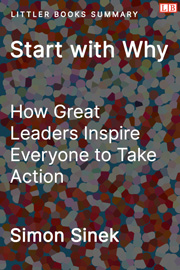Book Description
Why do some people and organizations clearly outperform their peers?
If You Just Remember One Thing
Understanding, communicating, and operating from your core purpose (your "why") is the key to achieving last... More
Bullet Point Summary and Quotes
- There are two ways to influence behavior, manipulation and inspiration.
- Manipulation tries to incentivize behavior through deals and marketing hype.
- Manipulation can work in the short-term but fails to build loyalty. When incentives are removed, manipulated customers will leave.
- Apple sells expensive products and doesn't offer deals or discounts yet has legions of loyal fans who support them.
- Successful companies understand their core purpose -- their why -- and use it to guide everything they do.
- “People don't buy what you do; they buy why you do it and what you do simply proves what you believe.”
- Inspiration comes from appealing to people's beliefs, values and purpose to motivate them. Get people to relate to your why.
- Northern California in the late 1960s was a hotbed of anti-establishment sentiment and revolution. Young people like Steve Jobs and Steve Wozniak embraced this spirit. The computer revolution was also unfolding, making personal computers seem within reach. Jobs and Wozniak saw an opportunity. For them, computers weren't about making money, but empowering individuals and challenging the status quo (Apple's slogan is “Think Different”) -- this was Apple's why.
- The Golden Circle describes the keys to enduring company success. It's three concentric circles representing why, how, and what.
- The outer circle is what -- the products/services a company provides.
- The middle circle is how -- how they provide those products/services.
- The inner circle is why -- the company's purpose, cause or belief.
- The why should be the core of the business. Start with the inner circle and work your way out.
- Starting with why resonates emotionally, as people are drawn to organizations with shared beliefs.
- Starting with why attracts innovators and early adopters critical for growth.
- Starting with why attracts passionate and like-minded employees.
- “Great companies don't hire skilled people and motivate them, they hire already motivated people and inspire them.”
- “You don't hire for skills, you hire for attitude. You can always teach skills.”
- Many founders don't know their why even though it's important. It's hard to inspire employees or attract loyal customers without knowing the why.
- To find your why, investigate yourself to find your purpose. Look to your past for clues. How were you perceived by others? What made you special?
- “Working hard for something we do not care about is called stress, working hard for something we love is called passion.”
- You need to communicate your why clearly and early.
- Refer to the Golden Circle when introducing a product. First explain the why, followed by the how and the what.
- Apple introduced the iPod by first stating the importance of music and revealing their intention to revolutionize how music is distributed and consumed (the why), then they talked about the how and finally revealed the iPod itself (the what).
- The Celery Test is a metaphor for making decisions guided by your organization's "why".
- Imagine you get advice to purchase various foods like candy, cheeseburgers, and celery. Without a clear why, you may try them all, spending time and money without results or visible purpose. With a clear why, like trying to be healthy, you only choose what aligns (celery).
- Knowing the why allows the Celery Test to provide a useful filter for decision-making.
- When leading companies drift from their guiding why to an obsessive focus on the what (e.g. finances), it's called "the split." Companies centered on metrics and not the mission lose their spark and stall.
- As a leader, your job should be focused on the why. Communicate the why to your employees regularly to inspire passion and trust. Get the right people to handle the how.
- “All organizations start with why, but only the great ones keep their why clear year after year.”
Start with Why: Resources
- Download this summary and 173+ other top nonfiction book summaries in one book (PDF, eBook, DOCX)
- Buy the book
